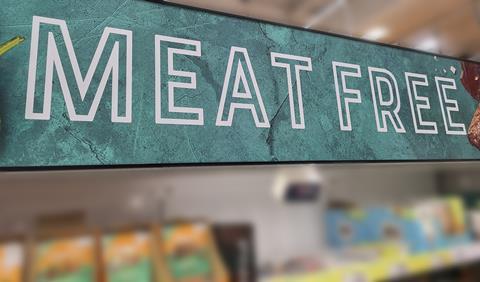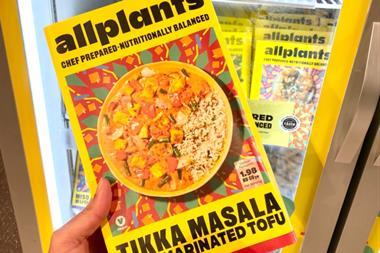
It’s open season on meat alternatives. There have been lots of conversations lately discussing the decline of the market – some have gone so far as to declare meat alternatives ‘just another food fad’.
After years of consistent double-digit sales growth, it feels premature of critics to set aside one of the defining consumer trends of our times, however.
This is not to pretend the category isn’t facing challenges. And it’s true, sales of meat alternatives are down. But let’s put this in perspective.
We have been through a global pandemic and are now experiencing a very real cost of living crisis. It’s no surprise consumers have become more price-conscious and are reverting to familiar choices. This means relatively new categories like plant-based are naturally being impacted.
However, while there has been some contraction, the trend is now stabilising. The chilled sector’s year-on-year decline has reduced to –6% (latest 12 weeks) versus –6.9% (latest 52 weeks), and the frozen sector is now at –2.5% (latest 12 weeks) versus –5.7% (latest 52 weeks) [NIQ]. Yes, there is decline, but it’s important to point out this isn’t a category in freefall. What’s more reassuring is that whether it’s the chilled or frozen meat alternatives category, the 2023 value sales are well ahead of 2019 levels, which we tend to benchmark against given it was prior to the pandemic spike of take-home food.
We also know, and this is critical to our confidence in plant-based, that the fundamental shopper needs that have driven plant-based over the past decade haven’t changed.
People still want healthier, more sustainable choices, and they want to eat less meat. In fact, one in five UK households have at least one member following a meat avoidance or reduction diet [Kantar]. But that’s not all: one of the defining factors that is key to unlocking success is creating high-quality and great-tasting products. Once shoppers know a product delivers on this, they are going to be back for more.
And with just 25% of UK households buying a chilled meat alternative each year, there is still a huge opportunity to convert flexitarians to the category.
To unlock this growth, retailers and brands need to focus on four key areas.
The first is innovation. As experts from Kantar recently stated in The Grocer, strong NPD is critical if brands want to stop consumers from trading down. This is especially true in a category like meat alternatives, which thrives on excitement and newness.
Our shopper research consistently shows browsing and product discovery are extremely important to consumers who buy into meat alternatives. Cutting back on NPD or reducing space for plant-based products would therefore be the wrong move at the wrong time.
Offering simple but tasty swaps for people’s favourite meals is the second focus for us. Flexitarians aren’t looking to make dramatic changes to their diets – they want to keep their current meal repertoire, just with a bit less meat. However, they will not compromise when it comes to quality or taste.
It’s one of the reasons why The Vegetarian Butcher is performing well. We’ve been focused on perfecting the taste and texture of our high-quality chicken alternatives, and in a market where repeat purchase rate has gone down 3% versus the year prior, The Vegetarian Butcher has increased its rate by 10% [Kantar].
To capture flexitarian shoppers and keep growing sales, we need to offer simple and convenient swaps for everyday dishes that deliver on taste to keep people repeat purchasing. With chicken featuring in 1.4 billion meal occasions each year [Kantar], our range, which includes a variety of cuts and even seasoned options, is a great stepping stone for people who are looking to make simple switches without any compromise.
The third area for unlocking growth is nutrition. What has become apparent over the past 12 months is that many consumers don’t know what goes into plant-based products. At a time when concerns about the nutritional value of products and the ingredients being used are on the rise, this is something the category needs to address head-on.
We can do this by being much more explicit in communicating the nutritional value of meat alternatives. We will be adding the traffic light system to the front of packs so consumers can see nutritional values at a glance. We are also calling out key claims such as ‘high in protein’ and continuously improving the nutritional quality of our range through product renovations that don’t compromise on taste.
Finally, there is audience and brand identity. Whether it’s targeting pre-family shoppers or the over-45s, both of whom are important demographics for meat alternatives, carving out a strong brand identity is a big opportunity to set ourselves apart from animal-based products and drive growth.
Meat is a traditional category that’s heavily driven by own label, with limited scope for branding and punchy front-of-pack communication. As a brand-led category, let’s make the most of our ability to engage and excite shoppers.
It’s been a challenging few months for plant-based, but the underlying fundamentals remain as strong as ever. Meat alternatives aren’t going away. In fact, we’re only getting started.
Have your say
The Grocer wants to hear from you about this article and the topics raised in it. If you would like to submit your opinion to be considered for publication in our letters section, get in touch at youropinion@thegrocer.co.uk



















No comments yet